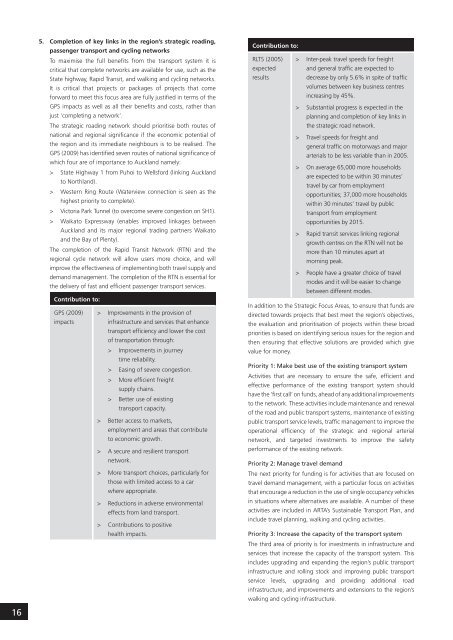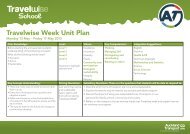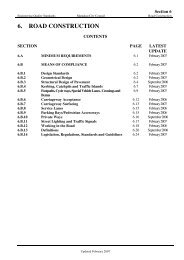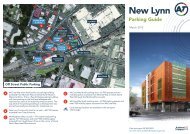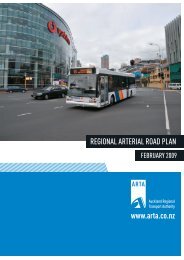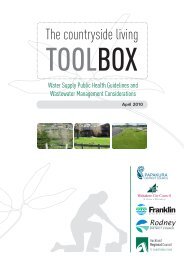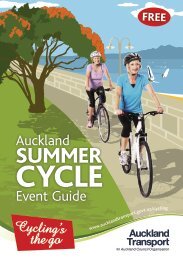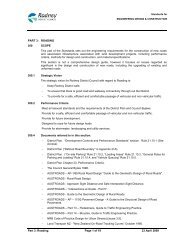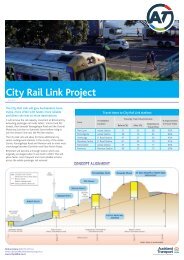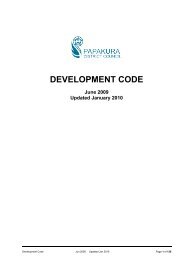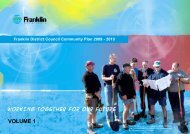Regional Land Transport Programme 2009 - 2010 (2MB) - Auckland ...
Regional Land Transport Programme 2009 - 2010 (2MB) - Auckland ...
Regional Land Transport Programme 2009 - 2010 (2MB) - Auckland ...
Create successful ePaper yourself
Turn your PDF publications into a flip-book with our unique Google optimized e-Paper software.
16<br />
5. Completion of key links in the region’s strategic roading,<br />
passenger transport and cycling networks<br />
To maximise the full benefits from the transport system it is<br />
critical that complete networks are available for use, such as the<br />
State highway, Rapid Transit, and walking and cycling networks.<br />
It is critical that projects or packages of projects that come<br />
forward to meet this focus area are fully justified in terms of the<br />
GPS impacts as well as all their benefits and costs, rather than<br />
just ‘completing a network’.<br />
The strategic roading network should prioritise both routes of<br />
national and regional significance if the economic potential of<br />
the region and its immediate neighbours is to be realised. The<br />
GPS (<strong>2009</strong>) has identified seven routes of national significance of<br />
which four are of importance to <strong>Auckland</strong> namely:<br />
> State Highway 1 from Puhoi to Wellsford (linking <strong>Auckland</strong><br />
to Northland).<br />
> Western Ring Route (Waterview connection is seen as the<br />
highest priority to complete).<br />
><br />
><br />
Victoria Park Tunnel (to overcome severe congestion on SH1).<br />
Waikato Expressway (enables improved linkages between<br />
<strong>Auckland</strong> and its major regional trading partners Waikato<br />
and the Bay of Plenty).<br />
The completion of the Rapid Transit Network (RTN) and the<br />
regional cycle network will allow users more choice, and will<br />
improve the effectiveness of implementing both travel supply and<br />
demand management. The completion of the RTN is essential for<br />
the delivery of fast and efficient passenger transport services.<br />
Contribution to:<br />
GPS (<strong>2009</strong>) > Improvements in the provision of<br />
impacts<br />
infrastructure and services that enhance<br />
transport efficiency and lower the cost<br />
of transportation through:<br />
> Improvements in journey<br />
time reliability.<br />
><br />
><br />
Easing of severe congestion.<br />
More efficient freight<br />
supply chains.<br />
> Better use of existing<br />
transport capacity.<br />
> Better access to markets,<br />
employment and areas that contribute<br />
to economic growth.<br />
> A secure and resilient transport<br />
network.<br />
> More transport choices, particularly for<br />
those with limited access to a car<br />
where appropriate.<br />
> Reductions in adverse environmental<br />
effects from land transport.<br />
> Contributions to positive<br />
health impacts.<br />
Contribution to:<br />
RLTS (2005)<br />
expected<br />
results<br />
><br />
><br />
><br />
><br />
><br />
><br />
Inter-peak travel speeds for freight<br />
and general traffic are expected to<br />
decrease by only 5.6% in spite of traffic<br />
volumes between key business centres<br />
increasing by 45%.<br />
Substantial progress is expected in the<br />
planning and completion of key links in<br />
the strategic road network.<br />
Travel speeds for freight and<br />
general traffic on motorways and major<br />
arterials to be less variable than in 2005.<br />
On average 65,000 more households<br />
are expected to be within 30 minutes’<br />
travel by car from employment<br />
opportunities; 37,000 more households<br />
within 30 minutes’ travel by public<br />
transport from employment<br />
opportunities by 2015.<br />
Rapid transit services linking regional<br />
growth centres on the RTN will not be<br />
more than 10 minutes apart at<br />
morning peak.<br />
People have a greater choice of travel<br />
modes and it will be easier to change<br />
between different modes.<br />
In addition to the Strategic Focus Areas, to ensure that funds are<br />
directed towards projects that best meet the region’s objectives,<br />
the evaluation and prioritisation of projects within these broad<br />
priorities is based on identifying serious issues for the region and<br />
then ensuring that effective solutions are provided which give<br />
value for money.<br />
Priority 1: Make best use of the existing transport system<br />
Activities that are necessary to ensure the safe, efficient and<br />
effective performance of the existing transport system should<br />
have the ’first call‘ on funds, ahead of any additional improvements<br />
to the network. These activities include maintenance and renewal<br />
of the road and public transport systems, maintenance of existing<br />
public transport service levels, traffic management to improve the<br />
operational efficiency of the strategic and regional arterial<br />
network, and targeted investments to improve the safety<br />
performance of the existing network.<br />
Priority 2: Manage travel demand<br />
The next priority for funding is for activities that are focused on<br />
travel demand management, with a particular focus on activities<br />
that encourage a reduction in the use of single occupancy vehicles<br />
in situations where alternatives are available. A number of these<br />
activities are included in ARTA’s Sustainable <strong>Transport</strong> Plan, and<br />
include travel planning, walking and cycling activities.<br />
Priority 3: Increase the capacity of the transport system<br />
The third area of priority is for investments in infrastructure and<br />
services that increase the capacity of the transport system. This<br />
includes upgrading and expanding the region’s public transport<br />
infrastructure and rolling stock and improving public transport<br />
service levels, upgrading and providing additional road<br />
infrastructure, and improvements and extensions to the region’s<br />
walking and cycling infrastructure.


